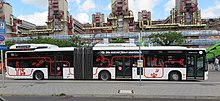Electric vehicle
An electric vehicle is a means of transport that is powered by electrical energy . This can mean road vehicles ( motor vehicles ), rail vehicles , watercraft or aircraft . Electric vehicles are supplied with drive energy in the form of electrical energy. This is stored in traction batteries in the vehicle or, if necessary, permanently supplied from the outside (e.g. busbar , overhead line , induction). The abbreviation BEV ( Battery Electric Vehicle ) is used internationally for battery-powered vehicles .
In hybrid vehicles , the electric drive is combined with another drive and the vehicles are also supplied with other energy sources, so they are not considered electric vehicles. A pedelec (a bicycle in which the driver is supported by an electric drive ) is a human-electric hybrid vehicle and is counted as a hybrid vehicle.
The use of electric vehicles is called electromobility .
history
The electric motor was after the steam engine , the second automatic Engine for vehicles. The combustion engine was only added later as a third type of drive . In the 1830s, Robert Anderson is said to have built an "electric cart". The first electric vehicles for rail transport were tested or operated in 1842 by Robert Davidson (1804-1894) on the Edinburgh - Glasgow route , in 1851 by Charles Grafton Page (1812-1868) near Washington, DC and in 1879 by Werner Siemens in Berlin .
The first three-wheeled electric vehicle for the road, the Trouvé Tricycle , was built by Gustave Trouvé in Paris in 1881. It is often confused with the Ayrton & Perry Electric Tricycle built a little later . While the Trouvé Tricycle still had the pedal drive (and thus represents a moped in the narrow sense ), the Ayrton & Perry Electric Tricycle could only be operated purely electrically.
The Flocken electric car , which was developed in 1888 by the Coburg manufacturer Andreas Flocken , is the first four-wheeled electric vehicle . This first "real" electric car was created by integrating an electric drive into a carriage. The carriage wheels were replaced around a decade later by wheels with rubber tires, which have remained the usual tires for electric cars to this day.
Types and names


In Germany, the names for electric vehicles are poorly systematized and not clear. Vehicle types are listed here according to the directory of the German Federal Motor Transport Authority .
Motor vehicles
Section 54 (5) lit. According to the 1960 Road Traffic Act , an externally chargeable motor vehicle with a drive train that contains at least one non-peripheral electric motor as an energy converter with an electrically chargeable energy storage system that can be charged externally is referred to as an electric vehicle.
- Motorcycles (L) - this includes two-, three-wheel and light four-wheel vehicles
- Small motorcycle (L1e, L2e): registration-free motorcycle with insurance number
-
Light vehicles (L6e): registration-free motorcycle with insurance number
- Light electric vehicle
- Neighborhood Electric Vehicle (NEV)
- Low-speed Electric Vehicle (LEV)
- Motorcycle (L3e, L4e): A motorcycle with an official registration number
- Three-wheeled motor vehicles (L5e): a motorcycle with an official registration number
- Light four-wheeled motor vehicles (L7e): a motorcycle with an official registration number
- (this type of vehicle is listed as motorcycles in the registration statistics of the Federal Motor Transport Authority )
- Light electric vehicle
- Neighborhood Electric Vehicle (NEV)
- Medium Speed Electric Vehicle (MEV)
- (this type of vehicle is listed as motorcycles in the registration statistics of the Federal Motor Transport Authority )
-
Passenger car (M)
- Electric car (e-car)
- Electromobile (E-Mobil)
- Hybrid electric vehicle
- trolleybus
- Duo bus
- omnibus
- Truck (N)
- Dump truck
Rail vehicles
- Electric railways , accumulator railcars
- S-Bahn
- Subways
- tram
- Magnetic levitation train
- Mine train
- Mountain railway and cable car , mostly via the cable drive
- Coaster
Watercraft

Aircraft
Other electric vehicles
- Electric bike without pedal drive (with pedal assistance it is a hybrid drive )
- Electric wheelchair
- TRIKKE eV (electric vehicle)
- Electric skateboard , electric motorized roller skates / inline skates
- purely electrically operated unicycle
- Segway with handlebar that can only be swiveled sideways
- Board for feet with legs apart, with a roll that rolls across the middle or wheels that roll lengthways on both sides, which control cornering via the difference in speed
- E-cart
- Electric carts , golf cart
- Electric forklift
- Solar vehicles
- Driverless transport vehicle
- Remote-controlled vehicles in the toy sector
- Delivery trolleys for milk and other "nocturnal" products in the vicinity
- Conductor cars - Bestattung Wien switched from gas to electric powered vehicles in 1991/92
- Building lift
literature
- Franz W. Peren, Nicola Sundermann, Beate Wittop: The electric car and its market. Campus, Frankfurt am Main 1997, ISBN 978-3-593-35700-3 .
- Heike Proff, Matthias Brand, Kurt Mehnert, J. Alexander Schmidt, Dieter Schramm (eds.): Electric vehicles for the cities of tomorrow: interdisciplinary design and testing in the DesignStudio NRW , Springer Gabler, Wiesbaden 2016, ISBN 978-3-658-08457 -8 .
- Philipp Richard Rainer Nobis: Development and application of a model for the analysis of grid stability in residential areas with electric vehicles, home storage systems and PV systems , supervisor: Ulrich Wagner. Reviewer: Ulrich Wagner; Christoph Weber University Library of the Technical University of Munich 2016, DNB 1110015178 (Dissertation Technical University of Munich 2016 full text online PDF, free of charge, 164 pages, 11,695,170 bytes).
Web links
- Frank Didik: History and Directory of Electric Cars from 1834 List of electric car manufacturers since 1834
- Overview of all current electric vehicles (both prototypes and series vehicles)
Individual evidence
- ↑ 2007–2011 Achmed AW Khammas In: Book of Synergy .
- ↑ Directory for the systematisation of vehicles 2012
- ↑ KBA: Methodological explanations for statistics, as of June 2012
- ↑ http://www.bestattungwien.at/eportal2/ep/programView.do?pageTypeId=75857&channelId=-54064&programId=74431&contentId=77403&contentTypeId=1001 History of Bestattung Wien, accessed June 5, 2016





